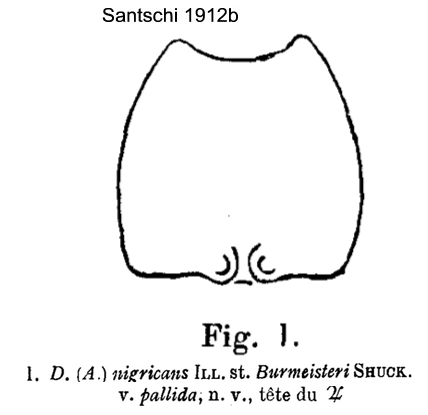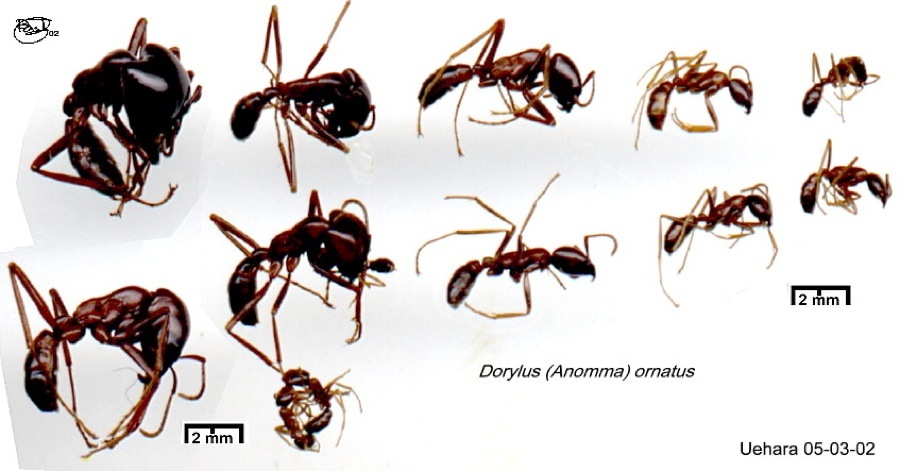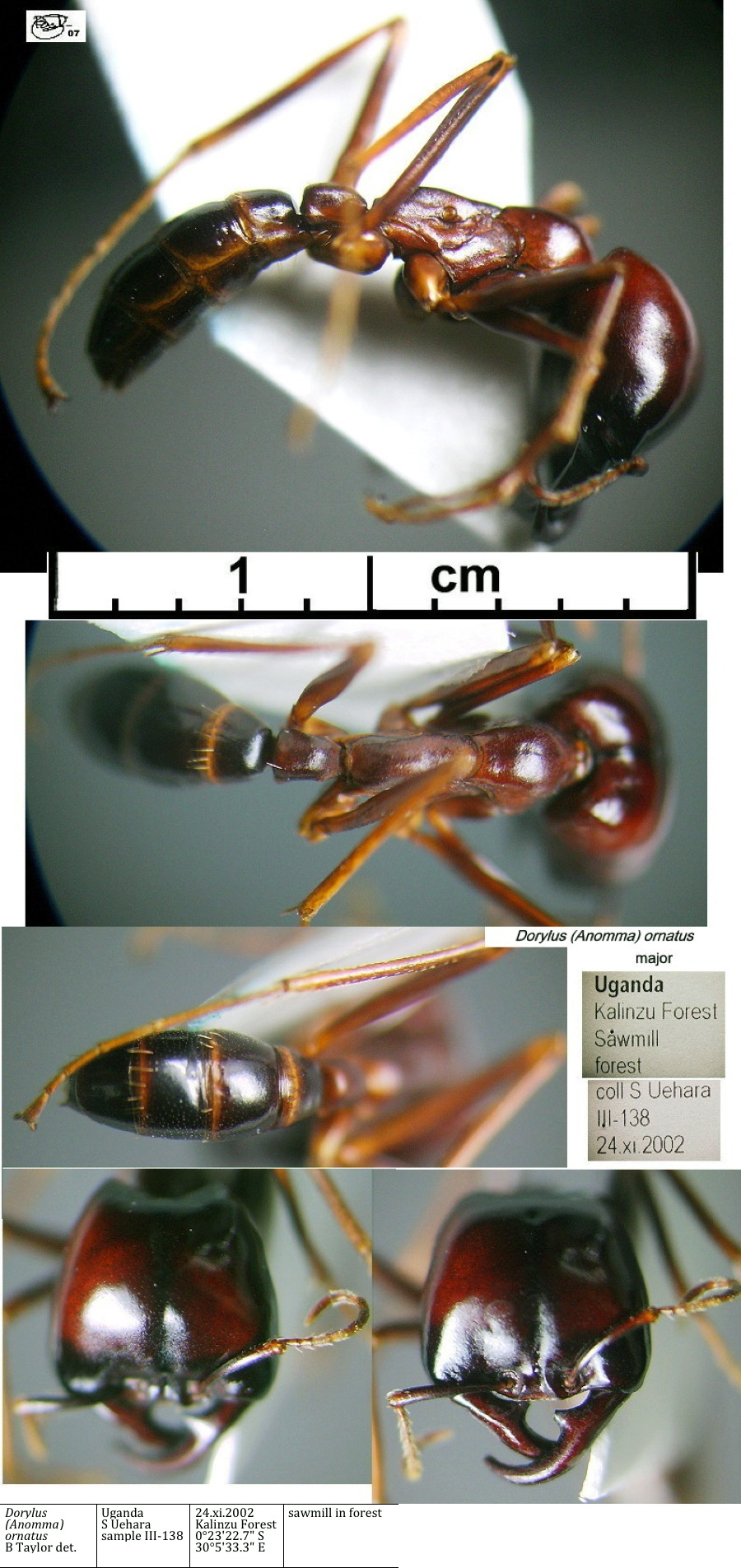Dorylus (Anomma) ornatus Santschi - new status
  Type location Cameroon
(Dorylus (Anomma) nigricans st. burmeisteri var. ornata,
in text by Santschi, 1912b: 161); Bolton has this as "unavailable
name"; see below. Type location Cameroon
(Dorylus (Anomma) nigricans st. burmeisteri var. ornata,
in text by Santschi, 1912b: 161); Bolton has this as "unavailable
name"; see below.  . .
|
 In
his key (Santschi, 1912b: 157) had: trapezoidal head; petiole wider
behind than in front, posterior angles sharp; head generally very
shiny; posterior angles of petiole not prolonged; colour bright red
with anterior angles of major head blackish, head widest in front and
with quite curved sides, shiny on the major. He did not illustrate ornatus but the head shape of Dorylus mayri and his burmeisteri var,. pallida also have the curved sides
to the head In
his key (Santschi, 1912b: 157) had: trapezoidal head; petiole wider
behind than in front, posterior angles sharp; head generally very
shiny; posterior angles of petiole not prolonged; colour bright red
with anterior angles of major head blackish, head widest in front and
with quite curved sides, shiny on the major. He did not illustrate ornatus but the head shape of Dorylus mayri and his burmeisteri var,. pallida also have the curved sides
to the head
Considered by Santschi (1912b, quoted in Raignier &
van Boven, 1955) as a form intermediate between rubellus and rufescens,
a somewhat odd statement (R & vB) but it was held at the time that rufescens
was a variety of burmeisteri. Santschi briefly noted how - it
recalls rufescens by its shape and colour but the head is shiny
in all individuals, as in rubella. I take as the type of the
variety ornata some examples from Cameroun (communicated by
Emery) with the colour wine-red with a sharp black anterior border to
the head. Raignier & van Boven commented how the resolution of the
validity of forms based on colour variation needed more samples than
they had before them [the latter is held here as no more than pale
specimens of burmeisteri, see above].
|
 The
photomontage of the type major is collated
from http://www.antweb.org/specimen.do?name=casent0911307. The
photomontage of the type major is collated
from http://www.antweb.org/specimen.do?name=casent0911307.
|
 The
photomontage of a type collection media worker is collated
from http://www.antweb.org/specimen.do?name=casent0911308. The
photomontage of a type collection media worker is collated
from http://www.antweb.org/specimen.do?name=casent0911308.
|
Oxford University Museum
specimens
Dorylus (Anomma) ornatus
B Taylor det.
|
Uganda
S Uehara
sample III-138
|
24.xi.2002
Kalinzu Forest
0°23'22.7" S
30°5'33.3" E
|
sawmill in forest
|
10
|
 |
Dorylus (Anomma) ornatus
B Taylor det. |
Tanzania
S Uehara
08-03-02
|
27.ii.2002
Mahale
60°15' S
29° 55' E
|
forest |
10
|
|
Dorylus (Anomma) ornatus
B Taylor det.
|
Tanzania
S Uehara
iii-138
|
05.iii.2002
Mahale
60°15' S
29° 55' E
|
jforest
|
2
|
|
Dorylus (Anomma) ornatus
B Taylor det. |
Tanzania
S Uehara
27-02-02
|
05.iii.2002
Mahale
60°15' S
29° 55' E
|
forest |
|
|
Dorylus (Anomma) ornatus
B Taylor det. |
Tanzania
S Uehara
iii-121x
|
08.iii.2002
Mahale
60°15' S
29° 55' E
|
forest |
|
|
|
 Polymorphism Polymorphism
The photomontages are of specimens from Tanzania
and Uganda. The former were from Mahale forest, collected by S. Uehara,
5 March 2002; they match Santschi's colour description very well.
Specimens were collected also on 2 March 2002 and 8 March 2002 but only
the 5 March specimens included the major morph. See the Mahale
Website for details of the research and location.
The number of specimens of all morphs, see the
polymorphism montage below, the consistency of the bright colour among
all the specimens, and the collection from three locations argue for
this as a valid species. In October 2003, Professor Uehara sent me
further samples with three sets of specimens from the Kalinzu Forest, Uganda
(30°07'E 0°17'S); all the sets matching the characters I have described
below.
The various morphs are shown in detail on the Dorylus (Anomma) ornatus
morphs page
|
 Full new description -
Kalinzu I-138[ Mahale 05-03-02 (dimensions, others without major
morphs); Mahale 02-03-02 and Mahale 08-03-02 Full new description -
Kalinzu I-138[ Mahale 05-03-02 (dimensions, others without major
morphs); Mahale 02-03-02 and Mahale 08-03-02
Overall - all over shiny to polished rich chestnut, darkest on apical
gaster and front of head; appendages golden chestnut
TL 9.9 HW 3.0 HL 3.0 HD 1.5 CI 100 SL 1.25 SI 42 AL 3.0 PW 1.25 PetL
0.65 GL 3.25 MFL 2.4
Head widest at about 1/4 length, narrowing to 2/3 at posterior; sides
smoothly convex; posterior margindeep near semicircular scallop,
posterior corners sharply rounded; sculpturation very highly polished,
almost totally effaced spiculation visible only in oblique light;
minutest of sparse hair pits; median line barely visible, most
noticeable as raised line in mid-occiput; clypeal margin very slightly
sinuous, with several long very fine hairs; mandible long and slender,
no subapical teeth or denticles, basal tooth moderately sized
equilateral triangle; scape relatively narrow, broadening from base to
apex, shiny, with sparse fine pilosity; funiculus all segments not much
longer than wide, bristly; head profile with dorsum bulbous, with
concave frontal area; venter in two distinct planes, anterior shallowly
convex, posterior 1/3 flat and angled to posterolateral processes
smaller than in wilverthi; minute stout hairs from hair pits.
Alitrunk - short and highly domed distinct "saddle"; spiracle large
circular and distinctly rearward facing; propodeum smoothly curved
front to back with no change in curve from dorsum into declivity;
metapleural gland upper flange hardly longer than lower; overall shiny
matte due to spiculation; minute sparse stout hairs on shoulders.
Petiole - relatively short with all edges rounded; distinct
posteroventral process; in dorsal view posterior about 1/3 wider than
anterior; spiracle small but very distinctly raised; ventral moderate
angular process; sculpturation as alitrunk; hairs single pair on
dorsum, few ventrally.
Gaster - base as petiole, rest smooth and shiny ; hairs not many
dorsally, but the same distinct micro, stout pilosity as pronotum and
head.
Legs - coxae relatively long; femora relatively long broad and shiny,
micropilosity as elsewhere; tibiae relatively long and broad apically,
finely bristly; tarsi moderately thick, bristly, exceptionally heavy
claws, last segment very hairy.
|
 Minima morph Minima morph
Head colour dark red chestnut, with distinct margin to anterior yellow
brown; dorsum with fine decumbent incurved pilosity; scape dark yellow
brown, apex lighter; funiculus yellow-brown, short and stout with
segments dark edged.
|
|